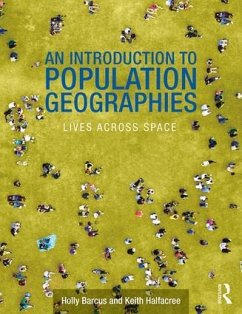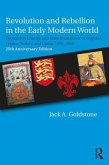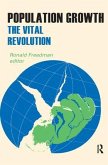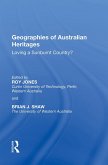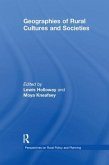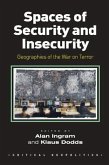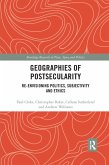Holly R. Barcus (US Macalester College), Keith Halfacree (UK. Swansea University)
An Introduction to Population Geographies
Lives Across Space
Holly R. Barcus (US Macalester College), Keith Halfacree (UK. Swansea University)
An Introduction to Population Geographies
Lives Across Space
- Broschiertes Buch
- Merkliste
- Auf die Merkliste
- Bewerten Bewerten
- Teilen
- Produkt teilen
- Produkterinnerung
- Produkterinnerung
This title provides a foundation to the field by establishing the substantive concerns of the sub-discipline, acknowledging the sheer diversity of its approaches, key concepts and theories. Written in an accessible style and assuming little prior knowledge of topics covered, the book discusses issues such as childhood and adulthood, family dynamics, ageing, everyday mobilities, morbidity and differential ability alongside the classic Population Geography triumvirate of births, migrations and deaths. Aimed at higher-level undergraduate and graduate students, this introductory text provides a…mehr
Andere Kunden interessierten sich auch für
![Thinking Space Thinking Space]() Mike Crang / Nigel Thrift (eds.)Thinking Space67,99 €
Mike Crang / Nigel Thrift (eds.)Thinking Space67,99 €![Revolution and Rebellion in the Early Modern World Revolution and Rebellion in the Early Modern World]() Jack A. GoldstoneRevolution and Rebellion in the Early Modern World55,99 €
Jack A. GoldstoneRevolution and Rebellion in the Early Modern World55,99 €![Population Growth Population Growth]() Ronald FreedmanPopulation Growth168,99 €
Ronald FreedmanPopulation Growth168,99 €![Geographies of Australian Heritages Geographies of Australian Heritages]() Roy JonesGeographies of Australian Heritages47,99 €
Roy JonesGeographies of Australian Heritages47,99 €![Geographies of Rural Cultures and Societies Geographies of Rural Cultures and Societies]() Moya KneafseyGeographies of Rural Cultures and Societies70,99 €
Moya KneafseyGeographies of Rural Cultures and Societies70,99 €![Spaces of Security and Insecurity Spaces of Security and Insecurity]() Alan IngramSpaces of Security and Insecurity69,99 €
Alan IngramSpaces of Security and Insecurity69,99 €![Geographies of Postsecularity Geographies of Postsecularity]() Paul Cloke (UK University of Exeter)Geographies of Postsecularity69,99 €
Paul Cloke (UK University of Exeter)Geographies of Postsecularity69,99 €-
-
-
This title provides a foundation to the field by establishing the substantive concerns of the sub-discipline, acknowledging the sheer diversity of its approaches, key concepts and theories. Written in an accessible style and assuming little prior knowledge of topics covered, the book discusses issues such as childhood and adulthood, family dynamics, ageing, everyday mobilities, morbidity and differential ability alongside the classic Population Geography triumvirate of births, migrations and deaths. Aimed at higher-level undergraduate and graduate students, this introductory text provides a well-developed pedagogy, including "real world" illustrations of theory, concepts and issues.
Produktdetails
- Produktdetails
- Verlag: Taylor & Francis Ltd
- Seitenzahl: 414
- Erscheinungstermin: 31. August 2017
- Englisch
- Abmessung: 246mm x 189mm x 22mm
- Gewicht: 778g
- ISBN-13: 9780415569958
- ISBN-10: 0415569958
- Artikelnr.: 43016513
- Herstellerkennzeichnung
- Libri GmbH
- Europaallee 1
- 36244 Bad Hersfeld
- gpsr@libri.de
- Verlag: Taylor & Francis Ltd
- Seitenzahl: 414
- Erscheinungstermin: 31. August 2017
- Englisch
- Abmessung: 246mm x 189mm x 22mm
- Gewicht: 778g
- ISBN-13: 9780415569958
- ISBN-10: 0415569958
- Artikelnr.: 43016513
- Herstellerkennzeichnung
- Libri GmbH
- Europaallee 1
- 36244 Bad Hersfeld
- gpsr@libri.de
Holly R. Barcus is a Professor and Chair in Geography at Macalester College, St. Paul, Minnesota, USA. Keith Halfacree is a Reader in Human Geography at Swansea University, Swansea, UK.
List of Figures
List of Tables
List of Boxes
Preface
Chapter 1: Viewing Populations Spatially: Population Geography as Lives
Across Space
1.1 Introduction: Lives Across Space
1.2 Of Populations and Population Geography
1.3 A Short History of Population Geography
1.4 Towards Relational Population Geographies
1.5 Lives Across Space
Chapter 2: Population Geographies of the Life Course
1. Introduction
2. Lives Individual and Common
3. Arenas of Differential Life Course Experience
4. Conclusion: Representing Lives Across Space
Chapter 3: Global Spatial Distributions of Population
3.1 Introduction: Snapshots of People in the World
3.2 The Populated World: a Global Demographic Perspective
3.3 The Populated World: Urban, Intra-Urban, Rural Spaces
3.4 Conclusion: Dynamism of Lives Across Space
Chapter 4: Fertility and Births
4.1 Introduction: Production of Children
4.2 Modelling Geographies of Fertility
4.3 Global Fertility Patterns
4.4 The "Value" of a Child
4.5 Managing Timing and Spacing of Births
4.6 State Policies and Fertility
4.7 "New" Fertilities
4.8 Conclusion: Fertility's Multiple Entanglements
Chapter 5: Placing Human Migration
5.1 Introduction: Defining Migration
5.2 The Era of Mobilities?
5.3 Migration as Natural Expression
5.4 Migration as Societal Expression
5.5 Migration as Individual Expression
5.6 Migration as Life Course Expression
5.7 Conclusion: Broadening Understanding of Human Migration
Chapter 6: From Everyday to Residential Mobilities
6.1 Introduction: Mobilities to Migrations
6.2 Everyday Mobilities
6.3 Residential Mobility
6.4 Conclusion
Chapter 7: Employment Migrations
7.1 Introduction: Beyond Commuting
7.2 Student Migrations
7.3 General Employment Migrations
7.4 Specialist Employment Migrations
7.5 Employment Migrations as Family and Community Practices
7.6 Conclusion
Chapter 8: Lifestyle Migrations
8.1 Introduction: Migration for the Project of the Self
8.2 The Lure of the City
8.3 The Lure of the Country
8.4 Lifestyle Retirement Migrations
8.5 Conclusion: Relational Lifestyle Migrations
Chapter 9: Forced Migrations
9.1 Introduction: the Importance of Labels
9.2 Recognizing Forced Migration and Mobilities
9.3 Forced Mobilities
9.4 Refugees, Internally Displaced Persons (IDPs) and Asylum-Seekers
9.5 Conclusion: looking beyond victimhood
Chapter 10: Mortality and Ageing
10.1 Introduction: the Ageing Body and the End of a Life Course
10.2 Elderly Lives
10.3 Mortality: Measurement and Global Trends and Patterns
10.4 Modeling Mortality Geographies
10.5 Differentiating Mortality: Causes of Death
10.6 Conclusion: Mortality, Resources and Access in an Ageing World
Chapter 11: 21st Century Lives Across Space
11.1. 21st Century Perspectives
11.2 21st Century Challenges
11.3 21st Century Populations
11.4 Conclusion: 21st Century Population Geography
Bibliography
Index
List of Tables
List of Boxes
Preface
Chapter 1: Viewing Populations Spatially: Population Geography as Lives
Across Space
1.1 Introduction: Lives Across Space
1.2 Of Populations and Population Geography
1.3 A Short History of Population Geography
1.4 Towards Relational Population Geographies
1.5 Lives Across Space
Chapter 2: Population Geographies of the Life Course
1. Introduction
2. Lives Individual and Common
3. Arenas of Differential Life Course Experience
4. Conclusion: Representing Lives Across Space
Chapter 3: Global Spatial Distributions of Population
3.1 Introduction: Snapshots of People in the World
3.2 The Populated World: a Global Demographic Perspective
3.3 The Populated World: Urban, Intra-Urban, Rural Spaces
3.4 Conclusion: Dynamism of Lives Across Space
Chapter 4: Fertility and Births
4.1 Introduction: Production of Children
4.2 Modelling Geographies of Fertility
4.3 Global Fertility Patterns
4.4 The "Value" of a Child
4.5 Managing Timing and Spacing of Births
4.6 State Policies and Fertility
4.7 "New" Fertilities
4.8 Conclusion: Fertility's Multiple Entanglements
Chapter 5: Placing Human Migration
5.1 Introduction: Defining Migration
5.2 The Era of Mobilities?
5.3 Migration as Natural Expression
5.4 Migration as Societal Expression
5.5 Migration as Individual Expression
5.6 Migration as Life Course Expression
5.7 Conclusion: Broadening Understanding of Human Migration
Chapter 6: From Everyday to Residential Mobilities
6.1 Introduction: Mobilities to Migrations
6.2 Everyday Mobilities
6.3 Residential Mobility
6.4 Conclusion
Chapter 7: Employment Migrations
7.1 Introduction: Beyond Commuting
7.2 Student Migrations
7.3 General Employment Migrations
7.4 Specialist Employment Migrations
7.5 Employment Migrations as Family and Community Practices
7.6 Conclusion
Chapter 8: Lifestyle Migrations
8.1 Introduction: Migration for the Project of the Self
8.2 The Lure of the City
8.3 The Lure of the Country
8.4 Lifestyle Retirement Migrations
8.5 Conclusion: Relational Lifestyle Migrations
Chapter 9: Forced Migrations
9.1 Introduction: the Importance of Labels
9.2 Recognizing Forced Migration and Mobilities
9.3 Forced Mobilities
9.4 Refugees, Internally Displaced Persons (IDPs) and Asylum-Seekers
9.5 Conclusion: looking beyond victimhood
Chapter 10: Mortality and Ageing
10.1 Introduction: the Ageing Body and the End of a Life Course
10.2 Elderly Lives
10.3 Mortality: Measurement and Global Trends and Patterns
10.4 Modeling Mortality Geographies
10.5 Differentiating Mortality: Causes of Death
10.6 Conclusion: Mortality, Resources and Access in an Ageing World
Chapter 11: 21st Century Lives Across Space
11.1. 21st Century Perspectives
11.2 21st Century Challenges
11.3 21st Century Populations
11.4 Conclusion: 21st Century Population Geography
Bibliography
Index
List of Figures
List of Tables
List of Boxes
Preface
Chapter 1: Viewing Populations Spatially: Population Geography as Lives
Across Space
1.1 Introduction: Lives Across Space
1.2 Of Populations and Population Geography
1.3 A Short History of Population Geography
1.4 Towards Relational Population Geographies
1.5 Lives Across Space
Chapter 2: Population Geographies of the Life Course
1. Introduction
2. Lives Individual and Common
3. Arenas of Differential Life Course Experience
4. Conclusion: Representing Lives Across Space
Chapter 3: Global Spatial Distributions of Population
3.1 Introduction: Snapshots of People in the World
3.2 The Populated World: a Global Demographic Perspective
3.3 The Populated World: Urban, Intra-Urban, Rural Spaces
3.4 Conclusion: Dynamism of Lives Across Space
Chapter 4: Fertility and Births
4.1 Introduction: Production of Children
4.2 Modelling Geographies of Fertility
4.3 Global Fertility Patterns
4.4 The "Value" of a Child
4.5 Managing Timing and Spacing of Births
4.6 State Policies and Fertility
4.7 "New" Fertilities
4.8 Conclusion: Fertility's Multiple Entanglements
Chapter 5: Placing Human Migration
5.1 Introduction: Defining Migration
5.2 The Era of Mobilities?
5.3 Migration as Natural Expression
5.4 Migration as Societal Expression
5.5 Migration as Individual Expression
5.6 Migration as Life Course Expression
5.7 Conclusion: Broadening Understanding of Human Migration
Chapter 6: From Everyday to Residential Mobilities
6.1 Introduction: Mobilities to Migrations
6.2 Everyday Mobilities
6.3 Residential Mobility
6.4 Conclusion
Chapter 7: Employment Migrations
7.1 Introduction: Beyond Commuting
7.2 Student Migrations
7.3 General Employment Migrations
7.4 Specialist Employment Migrations
7.5 Employment Migrations as Family and Community Practices
7.6 Conclusion
Chapter 8: Lifestyle Migrations
8.1 Introduction: Migration for the Project of the Self
8.2 The Lure of the City
8.3 The Lure of the Country
8.4 Lifestyle Retirement Migrations
8.5 Conclusion: Relational Lifestyle Migrations
Chapter 9: Forced Migrations
9.1 Introduction: the Importance of Labels
9.2 Recognizing Forced Migration and Mobilities
9.3 Forced Mobilities
9.4 Refugees, Internally Displaced Persons (IDPs) and Asylum-Seekers
9.5 Conclusion: looking beyond victimhood
Chapter 10: Mortality and Ageing
10.1 Introduction: the Ageing Body and the End of a Life Course
10.2 Elderly Lives
10.3 Mortality: Measurement and Global Trends and Patterns
10.4 Modeling Mortality Geographies
10.5 Differentiating Mortality: Causes of Death
10.6 Conclusion: Mortality, Resources and Access in an Ageing World
Chapter 11: 21st Century Lives Across Space
11.1. 21st Century Perspectives
11.2 21st Century Challenges
11.3 21st Century Populations
11.4 Conclusion: 21st Century Population Geography
Bibliography
Index
List of Tables
List of Boxes
Preface
Chapter 1: Viewing Populations Spatially: Population Geography as Lives
Across Space
1.1 Introduction: Lives Across Space
1.2 Of Populations and Population Geography
1.3 A Short History of Population Geography
1.4 Towards Relational Population Geographies
1.5 Lives Across Space
Chapter 2: Population Geographies of the Life Course
1. Introduction
2. Lives Individual and Common
3. Arenas of Differential Life Course Experience
4. Conclusion: Representing Lives Across Space
Chapter 3: Global Spatial Distributions of Population
3.1 Introduction: Snapshots of People in the World
3.2 The Populated World: a Global Demographic Perspective
3.3 The Populated World: Urban, Intra-Urban, Rural Spaces
3.4 Conclusion: Dynamism of Lives Across Space
Chapter 4: Fertility and Births
4.1 Introduction: Production of Children
4.2 Modelling Geographies of Fertility
4.3 Global Fertility Patterns
4.4 The "Value" of a Child
4.5 Managing Timing and Spacing of Births
4.6 State Policies and Fertility
4.7 "New" Fertilities
4.8 Conclusion: Fertility's Multiple Entanglements
Chapter 5: Placing Human Migration
5.1 Introduction: Defining Migration
5.2 The Era of Mobilities?
5.3 Migration as Natural Expression
5.4 Migration as Societal Expression
5.5 Migration as Individual Expression
5.6 Migration as Life Course Expression
5.7 Conclusion: Broadening Understanding of Human Migration
Chapter 6: From Everyday to Residential Mobilities
6.1 Introduction: Mobilities to Migrations
6.2 Everyday Mobilities
6.3 Residential Mobility
6.4 Conclusion
Chapter 7: Employment Migrations
7.1 Introduction: Beyond Commuting
7.2 Student Migrations
7.3 General Employment Migrations
7.4 Specialist Employment Migrations
7.5 Employment Migrations as Family and Community Practices
7.6 Conclusion
Chapter 8: Lifestyle Migrations
8.1 Introduction: Migration for the Project of the Self
8.2 The Lure of the City
8.3 The Lure of the Country
8.4 Lifestyle Retirement Migrations
8.5 Conclusion: Relational Lifestyle Migrations
Chapter 9: Forced Migrations
9.1 Introduction: the Importance of Labels
9.2 Recognizing Forced Migration and Mobilities
9.3 Forced Mobilities
9.4 Refugees, Internally Displaced Persons (IDPs) and Asylum-Seekers
9.5 Conclusion: looking beyond victimhood
Chapter 10: Mortality and Ageing
10.1 Introduction: the Ageing Body and the End of a Life Course
10.2 Elderly Lives
10.3 Mortality: Measurement and Global Trends and Patterns
10.4 Modeling Mortality Geographies
10.5 Differentiating Mortality: Causes of Death
10.6 Conclusion: Mortality, Resources and Access in an Ageing World
Chapter 11: 21st Century Lives Across Space
11.1. 21st Century Perspectives
11.2 21st Century Challenges
11.3 21st Century Populations
11.4 Conclusion: 21st Century Population Geography
Bibliography
Index

